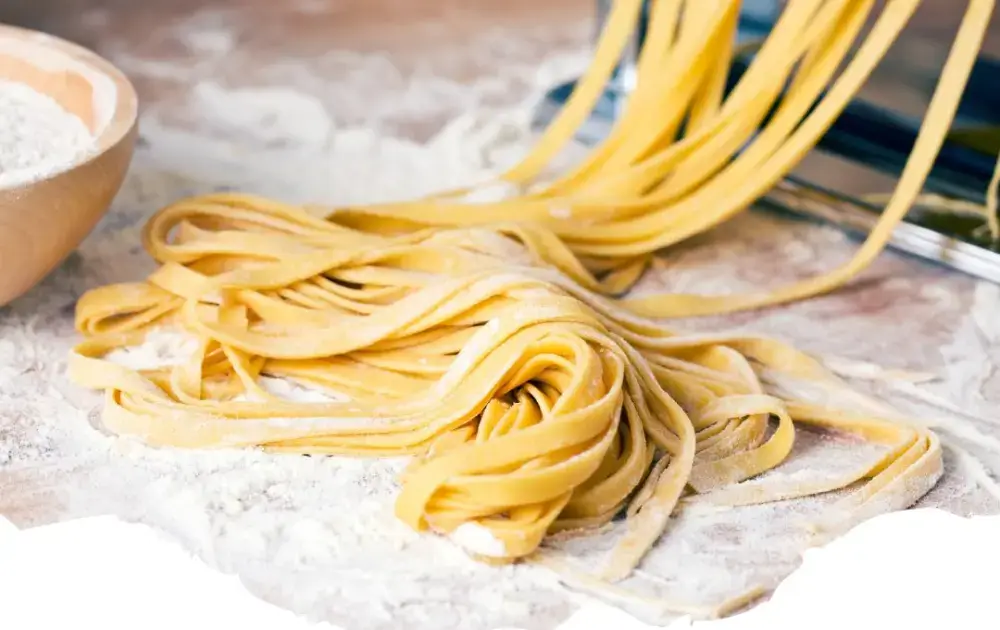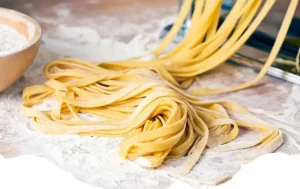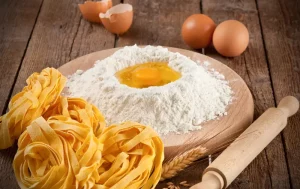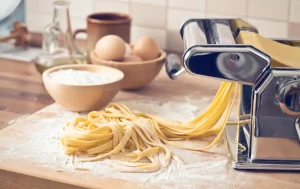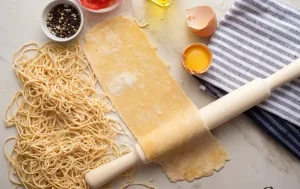Embarking on the journey of making fresh pasta dough from scratch is a rewarding culinary experience that transforms simple ingredients into a versatile foundation for countless Italian dishes. Unlike its dried counterpart, fresh pasta offers a tender, delicate texture that elevates any sauce it’s paired with, from the robust and hearty to the light and aromatic.
Gathering the Essential Ingredients
The beauty of fresh pasta dough lies in its simplicity, requiring only a few key ingredients:
- All-purpose flour or “00” flour for a more authentic texture
- Fresh eggs, which enrich the dough and add moisture
- Salt, to enhance the flavor
- Olive oil, for elasticity and richness
The Art of Mixing and Kneading
Begin by forming a well with the flour on a clean, flat surface and crack the eggs into the center. Add a pinch of salt and a drizzle of olive oil. Using a fork, gently beat the eggs, gradually incorporating the flour from the sides of the well. Once the mixture becomes too thick for the fork, switch to kneading with your hands. Knead the dough for about 10 minutes, or until it becomes smooth and elastic. This process develops the gluten in the flour, giving the pasta its structure and bite.
Resting the Dough
After kneading, the dough must rest to allow the gluten to relax, making it easier to roll out. Wrap the dough in plastic wrap and let it sit at room temperature for at least 30 minutes. This resting period is crucial for achieving the perfect texture in your finished pasta.
Rolling and Shaping
With the dough rested, it’s time to roll it out to your desired thickness. This can be done with a rolling pin or a pasta machine, depending on your preference and the tools available. The goal is to create a uniform sheet of pasta that can then be cut into various shapes and sizes, from wide pappardelle to thin spaghetti.
Cooking Fresh Pasta
One of the joys of fresh pasta is its quick cooking time. Boil a large pot of salted water and cook the pasta for just a few minutes, until it floats to the surface and is al dente. Fresh pasta’s delicate texture and flavor are best complemented by simple sauces that allow the quality of the homemade pasta to shine through.
Customizing Your Pasta
Fresh pasta dough is a canvas for creativity. Incorporate herbs, spices, or vegetable purees into the dough for added color and flavor. Spinach, beet, and squid ink are popular options for creating vibrant, flavorful pasta that adds a visual and taste sensation to any dish.
Making fresh pasta dough from scratch is not just about the end product but the process itself. It’s an opportunity to connect with the ingredients, the techniques, and the tradition of Italian cooking. Whether you’re a seasoned chef or a novice in the kitchen, the act of making pasta by hand is a deeply satisfying experience that rewards patience and practice with delicious results.
Exploring Regional Variations
Fresh pasta dough is not just a staple of Italian cuisine; it also reflects the diverse culinary traditions across Italy’s regions. From the egg-rich tagliatelle of Emilia-Romagna to the rustic, water-based dough of Puglia’s orecchiette, each region has its signature pasta shape and dough recipe. Exploring these variations provides insight into Italy’s rich culinary heritage and offers an array of flavors and textures to discover.
The Importance of Flour Choice
The choice of flour can significantly impact the texture and taste of your fresh pasta. While all-purpose flour works well for beginners, “00” flour, a finely ground Italian flour, is prized for creating a silky-smooth dough with just the right amount of chewiness. For those seeking a heartier texture, incorporating semolina flour, made from durum wheat, adds a rustic quality and golden hue to the pasta.
Mastering the Rolling Technique
Achieving the perfect thickness is crucial for the texture and cooking time of fresh pasta. When rolling out the dough, either manually with a rolling pin or mechanically with a pasta machine, aim for a consistency that’s thin enough to allow light to pass through but thick enough to hold the sauce. This balance ensures that the pasta cooks evenly and integrates seamlessly with the dish’s other components.
Drying and Storing Fresh Pasta
If not cooking immediately, fresh pasta can be dried or frozen for later use. To dry pasta, lay it flat or hang it on a pasta drying rack in a well-ventilated area until it’s completely dry to the touch. For freezing, place the pasta on a baking sheet in the freezer to prevent sticking, then transfer it to airtight bags. Properly stored, fresh pasta can be a convenient, homemade option for quick and delicious meals.
Pairing Pasta with the Right Sauce
The shape and texture of your fresh pasta play a significant role in sauce pairing. Delicate pasta shapes, like angel hair or thin sheets for ravioli, pair well with light, oil-based sauces that cling to the pasta without overwhelming it. Thicker, more robust shapes like fettuccine or pappardelle are ideal for hearty meat sauces or rich cream-based sauces, providing a satisfying bite that complements the sauce’s depth.
Celebrating Homemade Pasta
Making fresh pasta dough from scratch is a celebration of simplicity, tradition, and the joy of cooking. It’s an act that connects us to generations of pasta makers and invites us to put our personal touch on a dish that has been savored for centuries. Whether enjoyed in a simple weeknight meal or a lavish feast, homemade pasta is a testament to the beauty of handmade food, offering a taste experience that is both deeply personal and universally beloved.
Enhancing Flavor with Infused Doughs
One of the most creative aspects of making fresh pasta dough is the ability to infuse the dough with additional flavors. By incorporating ingredients such as pureed spinach, roasted red peppers, or herbs directly into the dough, you can create pasta that not only looks vibrant and appealing but also adds a subtle layer of flavor to your dish. This technique allows for endless experimentation, inviting you to tailor your pasta to complement specific sauces or themes in your cooking.
The Role of Resting in Pasta Perfection
Resting the dough before rolling and shaping is not merely a pause in the process; it’s a crucial step that contributes to the final texture and workability of the pasta. During this resting period, the gluten in the dough relaxes, making it easier to roll out without springing back. This ensures that the pasta can be thinned to the ideal consistency without tearing, leading to a superior mouthfeel and cooking performance.
Achieving Consistency in Pasta Thickness
Consistency in the thickness of your pasta is key to uniform cooking times and optimal sauce pairing. Using a pasta machine can help achieve this consistency, as the adjustable settings allow for precise control over the dough’s thickness. Whether rolling by hand or machine, aim for even, uniform sheets that cook evenly and provide the perfect foundation for your chosen sauce.
The Joy of Hand-Shaped Pasta
Beyond the satisfaction of making pasta dough from scratch, shaping the pasta by hand offers a tactile pleasure and a connection to traditional pasta-making techniques. From the simple elegance of hand-cut pappardelle to the intricate folds of tortellini, hand-shaped pasta carries the mark of the maker, adding a personal touch to the dish that cannot be replicated by machine-made pasta.
Savoring the Rewards of Homemade Pasta
The process of making fresh pasta dough from scratch culminates in the joy of sitting down to a meal that is the result of your own craftsmanship. The act of sharing homemade pasta with family and friends is not just about providing nourishment; it’s an expression of love and creativity, an offering that is as rewarding to make as it is to eat. Each bite of homemade pasta is a reminder of the beauty of simple ingredients transformed through skill and care into a dish that delights the senses and brings people together.
Making fresh pasta dough is a journey that spans cultures and generations, a testament to the enduring appeal of handmade food. It invites cooks of all levels to explore the art of pasta making, to experiment with flavors and techniques, and to discover the satisfaction of creating something truly special from the most basic of ingredients.
Navigating the World of Pasta Flours
When diving into the world of homemade pasta, the choice of flour can significantly impact the texture and flavor of the final product. Beyond the commonly used all-purpose and “00” flours, incorporating semolina flour introduces a desirable firmness and a golden hue to your pasta, ideal for shapes that need to hold robust sauces. Experimenting with whole wheat, spelt, or even gluten-free flour blends can also cater to dietary preferences, offering a range of textures and nutritional profiles.
The Significance of Pasta Drying Times
Drying your freshly made pasta plays a crucial role, especially if you’re not planning to cook it immediately. The drying time affects the pasta’s texture and shelf life. Short drying times retain more moisture, making the pasta ideal for immediate cooking, while longer drying ensures the pasta can be stored for future use without spoilage. Understanding the balance between drying and moisture content is key to perfecting your homemade pasta for various occasions.
Mastering the Sauce-to-Pasta Ratio
An essential aspect of serving the perfect pasta dish is mastering the sauce-to-pasta ratio. The goal is to achieve a harmonious blend where the pasta is evenly coated but not drowned in sauce. This balance ensures that the flavors are well distributed, allowing the pasta and sauce to complement each other without one overpowering the other. Remember, the pasta itself should be a star, with the sauce acting as a flavorful accent.
Exploring International Pasta Inspirations
While pasta is synonymous with Italian cuisine, exploring pasta dough variations inspired by other cultures can broaden your culinary repertoire. For instance, incorporating egg yolks into the dough as done in some regions of Italy for richer pasta, or exploring Asian noodle recipes that use rice flour or buckwheat, can introduce new textures and flavors to your homemade pasta dishes. This global approach to pasta making not only diversifies your menu but also pays homage to the universal love for noodle dishes.
The Community of Pasta Making
Engaging in the art of pasta making connects you to a community of enthusiasts and professionals who share a passion for this timeless culinary craft. Participating in workshops, sharing recipes online, or even hosting pasta-making parties can enhance your skills and deepen your appreciation for the nuances of different pasta types. This communal aspect of pasta making enriches the experience, making it not just about the food but also about the connections and memories formed around the pasta table.
Homemade pasta stands as a culinary tradition that marries simplicity with the potential for infinite creativity. Whether you’re rolling out sheets for lasagna, shaping delicate ravioli, or cutting strands for fettuccine, each step in the pasta-making process is an opportunity to infuse love and personal touch into your cooking. As you continue to explore and master the art of making fresh pasta dough, you’ll discover not just the joy of cooking, but the joy of creating experiences that linger long after the meal has ended.
FAQs about Fresh Pasta Dough
Can I make fresh pasta dough without a pasta machine?
Absolutely! While a pasta machine can help achieve uniform thickness, you can roll out pasta dough with a rolling pin. It might require more effort and patience to get it thin enough, but it’s entirely possible and quite rewarding.
How long can fresh pasta dough be stored?
Fresh pasta dough can be wrapped in plastic wrap and stored in the refrigerator for up to 2 days. For longer storage, you can freeze the dough for up to a month. Just thaw it in the refrigerator overnight before using.
Is it necessary to use “00” flour for pasta?
While “00” flour is often recommended for its fine texture and high elasticity, it’s not strictly necessary. All-purpose flour can also produce excellent results, making it a versatile and accessible option for homemade pasta.
Can fresh pasta dough be flavored?
Yes, you can flavor fresh pasta dough by incorporating herbs, vegetable purees (like spinach or beetroot), or spices into the dough mixture. This adds color, flavor, and nutritional value to your pasta.
Why does my fresh pasta come out tough?
Tough pasta usually results from not enough kneading or too little moisture in the dough. Ensure you knead the dough until it’s smooth and elastic and adjust the moisture with water or eggs if the dough feels too dry.
Conclusion
Making fresh pasta dough from scratch is a journey that brings the timeless beauty of Italian cuisine into your kitchen. It’s a process that invites creativity, from choosing your ingredients and flavors to mastering the art of rolling and shaping. Whether you’re a seasoned chef or a curious novice, the art of pasta making offers endless possibilities to explore flavors, textures, and culinary traditions. Each batch of fresh pasta dough not only promises a delicious meal but also an opportunity to connect with the rich heritage of pasta making. As you continue to experiment and refine your technique, you’ll find that homemade pasta isn’t just food—it’s a celebration of craftsmanship, tradition, and the simple joy of sharing a meal made with love.
Print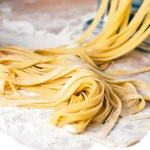
Fresh Pasta Dough
- Author: recipstep
- Total Time: 52 minute
- Yield: 4 servings 1x
- Diet: Vegetarian
Description
Fresh Pasta Dough is the foundation of many beloved Italian dishes, offering a tender and flavorful base that elevates any sauce it’s paired with. Making pasta from scratch allows for customization and ensures a texture that store-bought pasta can’t match. This simple yet versatile dough can be shaped into various forms, from spaghetti to ravioli, making it a staple in Italian cuisine.
Ingredients
2 to 2¼ cups all-purpose flour (240g-270g)
3 large eggs
1 tablespoon olive oil
½ teaspoon salt
Semolina flour for dusting
Instructions
Prepare the Dough:
On a smooth clean work surface, place 2 cups of flour in a mound.
Create a well in the center of the flour.
Crack the eggs into the well, add olive oil and salt.
Beat the egg mixture with a fork, gradually incorporating flour from the sides.
Knead the mixture until a shaggy dough ball forms.
Knead the Dough:
Knead the dough by hand for 10 to 15 minutes until smooth and elastic.
Add remaining flour if the dough feels sticky.
Rest the Dough:
Shape the dough into a ball and wrap tightly in plastic wrap.
Let the dough rest at room temperature for at least 1 hour, or refrigerate for up to 24 hours.
Roll Out the Dough:
Lightly dust a baking sheet with semolina flour.
Cut the rested dough into 4 equal pieces.
Press each piece into a rectangle, about ¼ inch thick.
Pass the dough through a pasta rolling machine on its widest setting.
Fold the dough and pass through again. Repeat this process.
Adjust the roller thickness gradually until desired thickness is achieved.
Shape the Pasta:
Sprinkle semolina flour on the pasta sheet.
Cut into desired shapes using a pasta cutter attachment or by hand.
Toss the shaped pasta in semolina flour and place on the prepared baking sheet.
Cook the Pasta:
Boil salted water in a large pot.
Drop the pasta into the boiling water and cook for 3 to 5 minutes until tender.
Stir occasionally.
Tips:
Adjust water or flour as needed to achieve a smooth dough consistency.
Allow the dough to rest to relax the gluten.
If no pasta machine is available, roll out the dough with a rolling pin, but expect more effort and time.
Alternatively, use a food processor to make the dough for quicker preparation.
Notes
- If the dough is too dry, add a teaspoon of water at a time until it reaches the right consistency.
- Resting the dough is crucial for developing gluten, which gives pasta its texture.
- The dough can be rolled out with a rolling pin or a pasta machine for more uniform thickness.
- Prep Time: 40 minutes (including resting)
- Cook Time: 2-4 minutes
- Category: Main Course
- Method: Kneading, Boiling
- Cuisine: Italian
Nutrition
- Calories: 290
- Sugar: 1g
- Sodium: 300mg
- Fat: 5g
- Carbohydrates: 50g
- Fiber: 2g
- Protein: 10g

